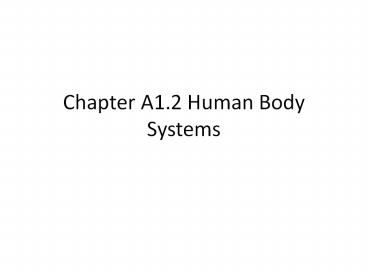Chapter A1.2 Human Body Systems - PowerPoint PPT Presentation
1 / 14
Title:
Chapter A1.2 Human Body Systems
Description:
Chapter A1.2 Human Body Systems The Circulatory System The circulatory system transports oxygen, nutrients, and wastes through the body in the blood. – PowerPoint PPT presentation
Number of Views:236
Avg rating:3.0/5.0
Title: Chapter A1.2 Human Body Systems
1
Chapter A1.2 Human Body Systems
2
The Circulatory System
- The circulatory system transports oxygen,
nutrients, and wastes through the body in the
blood. - The liquid part of the blood, called plasma, is
mostly water. - Plasma also contains dissolved nutrients and
waste products. - The waste product in blood is what we call carbon
dioxide.
3
continued
- The solid part of blood contains red blood cells
and white blood cells. - Red blood cells absorb oxygen and deliver it to
the organs. - White blood cells help the body fight infection.
They attack and destroy the germs and viruses and
bacteria that enter the body.
4
continued
- Blood also contains platelets tiny pieces of
blood cells inside membranes. - Platelets cause blood cells to clot when a cut or
open wound occurs. - They also repair damage to your blood vessels.
- The heart pumps blood through blood vessels. The
oxygen rich blood flows through the body through
arteries, and returns to the heart and lungs
through veins.
5
continued
- Capillaries- are blood vessels so small that the
red blood cells have to travel through single
file. - There are capillaries throughout the body so that
oxygen can reach every part of your body.
6
The Respiratory System
- When you breathe, you draw air into your lungs.
- The air is filtered by tiny hairs inside your
nose and warmed by capillaries. - The warmed air then travels down your trachea, or
windpipe. - The trachea branches into smaller tubes called
bronchi.
7
continued
- Each bronchi tube leads to one of the lungs.
- In the lungs, the tubes divide smaller and
smaller. - At the end of the smallest tubes, there are tiny
air sacs called alveoli. - The walls of the alveoli are only one cell thick.
- The blood coming from the heart contains much
carbon dioxide.
8
continued
- Carbon dioxide diffuses through the walls of the
alveoli and then into the air you will breathe
out. - When you breathe in, the air diffuses through the
alveoli and into the red blood cells. The oxygen
rich blood then flows back to the heart. The
heart then pumps the oxygenated blood
throughout your body.
9
The Digestive System
- Digestion starts as soon as you chew your food.
Your chewing breaks the food into smaller pieces
and mixes with your saliva. - Saliva moistens the food and begins to break down
the starchy foods into sugars. - When you swallow, food goes through your
esophagus, a long tube from your mouth to your
stomach.
10
continued
- Juices in your stomach containing acid and other
chemicals break down the proteins. - After several hours in your stomach, the digested
food moves into your small intestine. - In the small intestine, more chemicals break down
the food. Nutrients from the food are now able
to diffuse through the villi, tiny finger like
structures, into the blood.
11
continued
- Undigested food then travels to the large
intestine, where water and minerals pass into the
blood, and non-needed material are removed from
the body. - Two other organs aid in digestion. The liver
produces bile, which is stored in the gallbladder
until you need it. The pancreas produces a fluid
that calms stomach acid and other chemicals that
help complete digestion.
12
The Excretory System
- The waste left over from the circulatory system
must be removed from the blood. The food
material not used by the body must be removed
from the intestine. This is the job of the
excretory system. - Cell wastes include carbon dioxide and ammonia.
- Ammonia travels to the liver where it is
converted into urea.
13
continued
- The urea then travels by way of the blood to the
kidneys. - The urea, water and other wastes then form urine
and it flows from the kidney to the bladder
through tubes called ureters. - You empty the bladder when it is full through a
tube called the urethra.
14
continued
- The body gets rid of wastes in other ways too.
When you exercise you get warm and sweat. Sweat
is a salty liquid that cools your body when it
evaporates.

